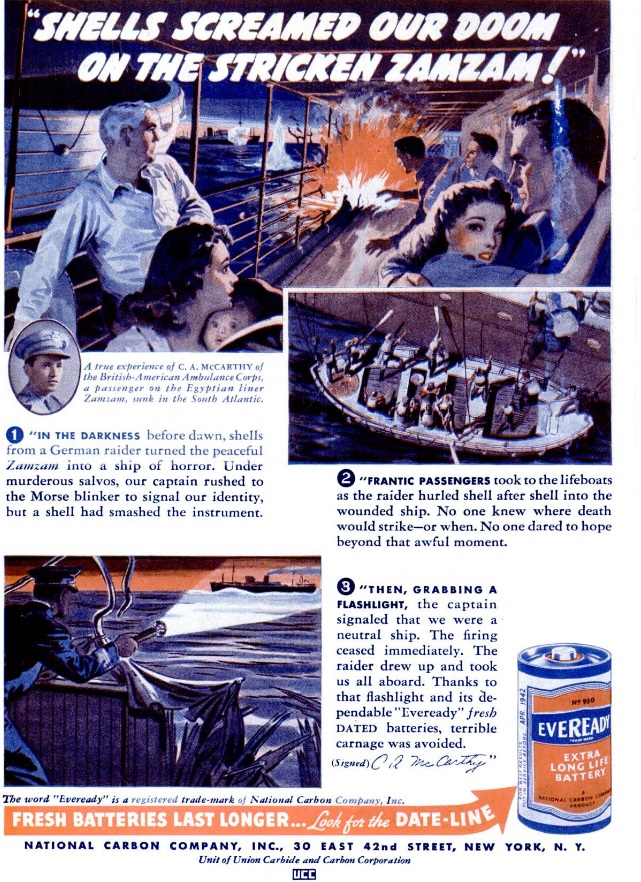This advertisement for Eveready batteries appeared 75 years ago this month in the November 1936 issue of Popular Science. I had never heard of the Zamzam, but her last voyage is a fascinating but forgotten story of the Second World War.
I haven’t found any independent verification of the claim in the ad, that the Captain used Eveready batteries to avert disaster. But whether or not he did, it’s a compelling story.
The Zamzam set sail from New York in the Spring of 1941 under the Egyptian flag, bound for Egypt by way of South America and South Aftica. Built in 1909, she originally bore the name Leicestershire and flew the British flag. She first served as a passenger ship to India, and during the First World War, she served as a troop carrier, carrying troops to Russia and repatriating Australian troops after the war. After the war, she was modernized to burn oil rather than coal, and resumed passenger service to Rangoon until 1930.
In that year, she was sold to the British National Exhibition Ship Company Ltd., and was renamed the British Exhibitor, where she was to serve as a floating expedition showcasing goods throughout the Empire. When that company went into liquidation, the ship was purchased by the Egyptians, where she transported 600 pilgrims at a time from Suez to Mecca for the next eight years.
With the outbreak of war, the Zamzam was pressed into service carrying passengers between Egypt and New York. The first trip to New York was apparently uneventful, but her last voyage was the return trip.
The ship left Hoboken, New Jersey, on March 20, 1941, with 201 passengers aboard. To avoid war zones, the neutral ship would sail to Trinidad, thence to Recife, Brazil, across the Atlantic to Capetown, South Africa, and then up the east coast of Africa to Mombasa, Kenya, and then to Alexandria, Egypt.
The largest contingent of passengers consisted of 144 missionaries, representing both Catholic and Protestant denominations. Interestingly, the contingent of missionaries from the Augustana Lutheran Church were on their way to Tanzania, where they were to replace German Lutheran missionaries interned by the British.
The passengers also included a group of ambulance drivers from the British-American Ambulance Company, en route to North Africa to serve as ambulance drivers for British forces. There were also a group of American tobacco buyers en route to Rhodesia. Most passengers were American, but there were a large number of Canadians. The missionaries in particular included many women and children among their numbers.
Joining the passengers in Brazil were Life magazine photographer David E. Scherman and Fortune magazine editor Charles J.V. Murphy, who documented the later sinking.
A few days after leaving New York, the passengers were startled when the crew began painting over the portals and announcing that the ship would be travelling in strict blackout conditions. This prompted considerable protest by the passengers, who had believed that they would be traveling openly under the protection of a neutral flag. The captain, a British officer, insisted that he was acting under orders of the Admiralty, to the great consternation of passengers. The ship traveled under strict blackout, and no light, not even a lit cigarette, was permitted on deck.
During the early morning hours of April 17, the German raider Atlantis (also known as the Tamesis), a reflagged Norwegian freighter, attacked. The passengers donned life jackets and boarded lifeboats and the ship sunk. Since some of the lifeboats had been damaged, a number of passengers were forced to float in the water.
Just as the raider hoisted its Nazi flag and its crew were stationed at machine guns, a rainbow appeared in the morning sky. Eventually, the survivors signaled (presumably with the captain’s Eveready flashlight) that the ship was neutral. The German ship took the survivors aboard, and the captain discovered to his dismay that many of the passengers were Americans.
By all accounts, the captain, Bernhard Rogge, treated the prisoners humanely, and they were transferred a few days later to another ship which eventually transported them to occupied France. The Americans were repatriated fairly rapidly through Spain and Portugal, but the Canadians were interned.
The Catholic missionaries were American born, but were traveling under Canadian passports to expedite entry into South Africa. In retrospect, the decision was undoubtedly regretted, since they were interned with the other Canadians. This turned out to be a fortunate circumstance for the Germans, since the Geneva Convention required them to provide chaplains for POW’s, a role which these prisoners took on.
Eventually, seven of the Canadian women were to be exchanged for German women being held in Canada. At some point, they were placed on a train to Berlin. Unfortunately, nobody had bothered to tell Berlin that they were coming, and they were left to their own devices in the enemy capital. They made contact with American journalists and diplomats, and were eventually returned to Canada.
During their stay, however, they were forced to obtain food in the local economy along with the Germans. One butcher, recalling his humane treatment by the allies as a prisoner in the previous war, greeted them in English each time they entered his shop, and allowed them to the front of the line, somewhat to their embarrassment.
This video, prepared by one of the predecessors of the Evangelical Lutheran Church in America, is a fascinating look at the bizarre odyssey of these missionaries.
References
- The Zamzam Story
- Life Magazine, June 23, 1941
- The Accidental Captives: The Story of Seven Women Alone in Nazi Germany
- Archives at Wheaton College

